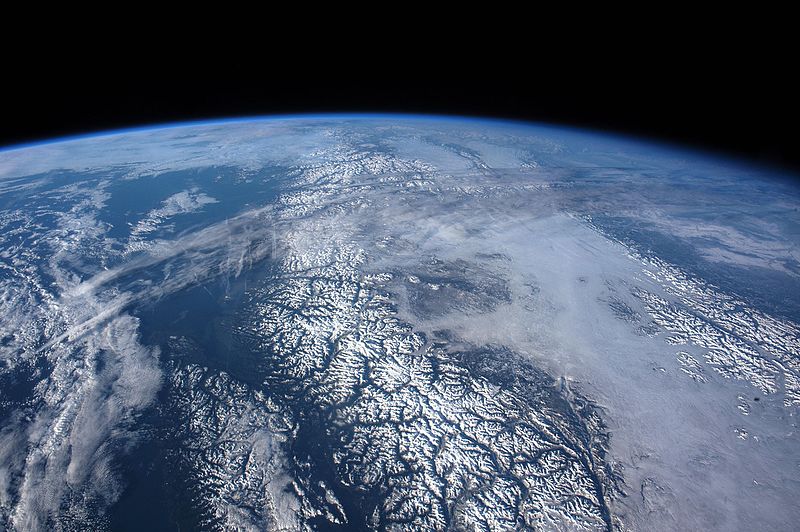English: While orbiting over the Gulf of Alaska and moving toward the west coast of the United States, an astronaut aboard the International Space Station shot this panorama looking north into the snow-covered landscape of Canada’s Coast Mountains, the Canadian Rockies, and Vancouver Island. Numerous dark valleys contrast with the brilliant snow, even in the low light of a northern winter. The valleys were eroded by glaciers repeatedly in various ice ages over the past 2 to 3 million years.
Low stratus clouds mask the 250-kilometer (150-mile) wide plateau between the mountain ranges. Above these clouds, a long cloud band slants across the image. Meteorologists think this may be the remnants of a jet stream cloud band. Such jet stream bands indicate the general position of these fast “rivers of air.” Based on its northeast orientation, its altitude, and its linear appearance, the cloud band is in the typical position and orientation of the Polar Jet, which blows northeast towards Hudson Bay, then dives south over the southeastern provinces of Canada. Animated maps of the Polar Jet for the days before this image show a dying branch of the jet over western Canada.
Even in this distant view, several thin contrails appear, disrupting the jet band and showing where aircraft flew in and near the jet stream. Aircraft take advantage of these fast jets (which can reach speeds of more than 440 kilometers or 275 miles per hour) as tail winds that can shorten flight times.
Français : Alors en orbite au-dessus du golfe de l'Alaska et se dirigeant vers la côte ouest des États-Unis, un astronaute à bord de la Station spatiale internationale a photographié ce panorama face au nord, les montagnes côtières couvertes de neige, des Rocheuses canadiennes et de l'île de Vancouver. De nombreuses vallées sombres contrastent avec la neige brillante, même à la faible lumière d'un hiver nordique. Les vallées ont été érodées par les glaciers à plusieurs reprises au cours des différents âges glaciaires des 2 à 3 millions d'années passées.
Les nuages de stratus masquent le plateau large de 250 kilomètres entre les chaînes de montagnes. Au-dessus de ces nuages, une longue bande de nuages flotte au travers de l'image. Les météorologues pensent que ce peut être les restes d'une bande nuage d'un courant-jet. En raison de son orientation nord-est, de son altitude et de son aspect linéaire, la bande de nuages se trouve dans la position et l'orientation typiques du jet polaire qui souffle vers le nord-est de la Baie d'Hudson, puis plonge vers le sud sur les provinces du sud-est du Canada. Les cartes animées du Jet Polaire des jours précédant cette image, montrent une branche mourante du jet sur l'ouest du Canada.
Même par cette vue lointaine, plusieurs traînées minces apparaissent, perturbant la bande du jet et montre où l'avion a volé, près du courant de jet. L'avion profite de ces jets (qui peuvent atteindre des vitesses de plus de 440 kilomètres à l'heure) que les vents de queue raccourcissent les temps de vol.





